
As many people either knew or guessed, it’s a sketch concerning Ulysses, that novel routinely claimed as the best or most influential tome in 20th century literature, and written of course by James Joyce, (below).

I came across the drawing a few weeks back, while researching a new walking route around Dublin, a route which will be loosely based on that iconic novel.
As one or two readers also knew, this particular map was drawn- presumably as an aid to study- by another great novelist, the Russian writer Vladimir Nabokov, of Pale Fire and Lolita fame. (pictured below)
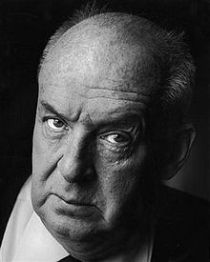
Like many 20th century writers, Nabokov was greatly influenced by Joyce. Indeed, he was not adverse to some Joycean playfulness in his own work. Take for example, the fictional forward to Lolita, purportedly written after the death of fictitious anti-hero and pederast scholar Humbert Humbert.
As for his pencil drawing above, to help us understand it, and the small pencil numbers on it, it’s worth noting that Nabokov is only concerned here with the peregrinations of Leopold Bloom on Thursday, June 16 of 1904, but not the related journey of Stephen Daedalus that same day. Read More…
Because the first three episodes of Ulysses: “Telemachus; “Proteus; “Nestor”; ( the three episodes collectively termed the Tellemachid) concern Stephen Daedalus, and not Bloom, they’ve been disregarded here by Nabokov.
Conversely, Leopold Bloom, although the hero, doesn’t appear until the third chapter, (more correctly the “episode”- Callypso) up in the house that he and Molly Bloom share at number 7, Eccles Street.
Accordingly Nabokov only starts noting and numbering each episode only from this point onwards, using those small Roman numerals scrawled in pencil on his map. (Nabokov’s map pictured again below)
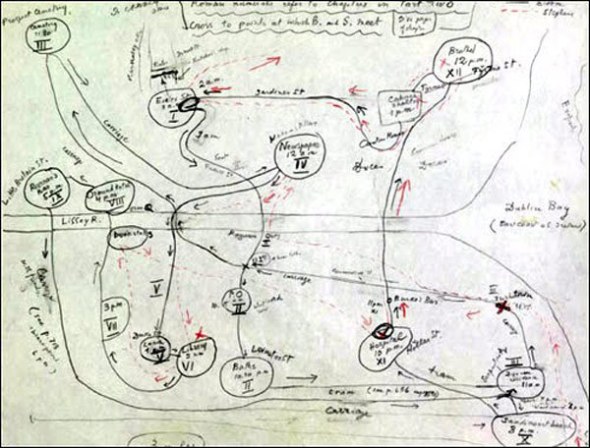
So, this episode “Callypso”- the first to concern Bloom, but the fourth chapter of the novel- is denoted as I, not IV; Bloom’s second episode (Lotus Eaters) as II not V; the sixth as IV, not VII, and so on.
This gets a little confusing by the time Nabokov gets to the episode called Sirens. “Sirens” sees Bloom having dinner with Stephen’s father in a hotel following their return from Paddy Dignam’s funeral, and listening to music there. (In fact the entire episode is constructed along musical lines)
This is Chapter 11 of the novel, but in Nabokov’s system it is only 8: VIII. That proved confusing, for a bear of little brain like me at least, because it takes place in a hotel, (the old Ormond hotel, on the Quay of that name) while a substantial part of the “real” chapter 8/VIII (Lestrigoninans) also features a hotel: the Burton hotel.
I did ask readers if the great Russian had made a mistake, so I’d better just come clean. I thought (with misplaced glee) that Nabokov had made an error, and got his hotels mixed up basically.
But, as it turned out, the error was all mine.
Can you hear his callous, Russian-tinted laughter, echoing from the grave? Mwa-ha-ha….
Casting about for other possible errors, one reader also suggested that Nabokov had mis-named our National Cemetery. A plausible suggestion, since all Dubliners know the last resting place of Parnell, Daniel O’Connell et al as Glasnevin Cemetery. And, if you look at our map again, you’ll see Nabokov has called it “Prospect Cemetery”.
But no, it turns out, even this is no mistake. Mount Prospect was, and apparently is still is, the official name of Glasnevin. They are one and the same place-, which, I have to say was news to me. The great Russian did not put a foot wrong here either. My apologies to Vladimir. (and please stop that hideous laughing)
Despite my errors, I found the business of researching a new Ulysses walk fascinating, since it turned up many morsels, like his wonderful map here.
Clearly the Russian novelist was seeking to create a mental picture of the city and the crisscrossing of routes and even perhaps, trying to test and calculate journey times: to test and fix times in the novel, especially since during several sections of the book. Joyce allows time to become extremely vague.
Even more, Nabokov seems to have been trying to form a more three-dimensional, more spatial understanding of the novel.
That is a worthwhile pursuit. Rewards lie in wait for the serious student. The novel is full of games and tricks.
One amusing challenge, set by Joyce to his readers was to contrive a route through Dublin that does not pass a single pub. Believe it or not, that riddle was only cracked a few years ago, in June 2011, by mean of an algorithm written by one Rory McCann, a 27-year old Irish software developer.
Over the last few years, a team headed Professor Joseph Nugent, Professor of English at Boston College, and his technologist collaborator, Dr. Tim Lindgrin, have created a wonderful interactive map of the Dublin of Ulysses.
Their fabulous map can be scrolled around, and searched, by chapter or by episode, or by reference to characters, to buildings or events. (a link to the Boston college Mapping Ulysses project is provided at the foot of this post ) Granted, the annotation provided by Boston College team are by no means complete or exhaustive but their map is still undoubtedly a wonderful, highly useful, even immersive resource, for all students of the novel. And it certainly helps us in a greater undertsanding of that novel, an understanding more spatial, and more, 3-dimensional. All of which, I’d venture, also assists us in turn to a more temporal understanding of Bloom’s (and Stephen’s) experience as well. Thier lived, felt, breathed, experience, minute to minute, of the city, what they see, who they meet, everything. Simply knowing where they are, helps us to visualise what is physically around the next corner, or over the next bridge, and this to give physical context to each meeting, thought and incident that occurs within the book.
Meanwhile, the same map resource, also, certainly, helps reveal some of the strange games Joyce was playing…. Let’s just look at one example below. Have a careful look below, please, at this section of Dublin, walked by Leopold Bloom in the episode Lotus Eaters.
Please ignore the red lines on the map, which are irrelevant to the novel: and concentrate instead on the blue line, which is Bloom’s walking route. Now have one really good, long look, and “see what you can see” (?)
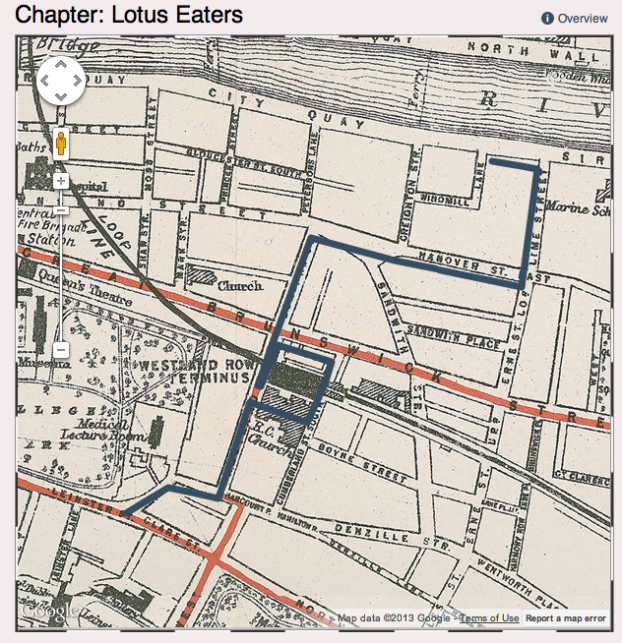
Still Looking ? I’m waiting for you to see it…..
Okay?
Did you see above how Leopold Bloom’s route, appears to form at least one, and maybe even two, question mark shapes, on the map?
It is something you never, would or even could, realize, until or unless you see Bloom’s route traced on a map this way. Yet, despite this “hidden quality” the question mark shapes are certainly no accident. On the contrary, Joyce reveled in such diversions.
But, why have a question mark, you might ask, in this specific part of the novel? Well, probably (scholars have suggested) because Leopold is on his way to collect and to read a letter. His wife (Molly) is having an affair of course, with the jaunty or even cocky character of Blazes Boylan) But so is poor Bloom himself, involved in a less satisfactory, in fact rather half-arsed, furtive sort of relationship, one which seems to place almost entirely by letter. In fact, or as I understood it anyway, there’s the impression poor Leopold is even the victim of a sort of “Romantic letter” confidence trick and is being milked for cash. But in any case, this is not relevant at this point. What matters is that Bloom wants the letter, badly and is one his way to collect it and then to read it. So, he is excited, burning with curiosity, agitated, even aroused. He wants to know: Will the letter be there? - and - What will she say this time? Hence his route, forming “questions” on the map.
****************
In later 20th century literature, other writers, like the Oulipo group in France, were inspired by Joyce to play out similar games- notably the singular, endlessly playful genius of Georges Perec. (below)
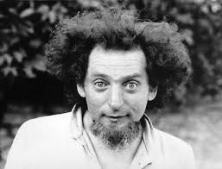
Perec’s greatest novel, “Life: a User’s Manual” features an invisible eye, wandering around a block of Paris flats. But each move through the apartment block follows the L-Shaped movement of a knight, from a game of chess.
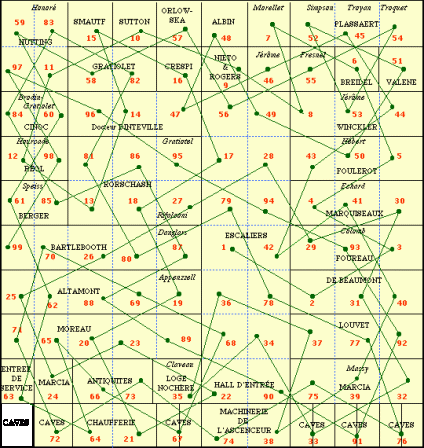
It’s an apt device, in a dazzling novel packed with plots and ploys, and where the clef for this very special roman is a cruel trick, played out by means of an other puzzle, a jigsaw puzzle.
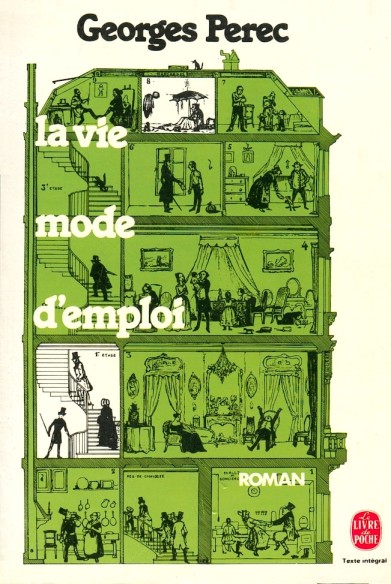
As for Mr. Joyce, he boasted, famously, that we would all be studying his novel for a hundred years or more.
Even that may turn out to be a cautious estimate.
END